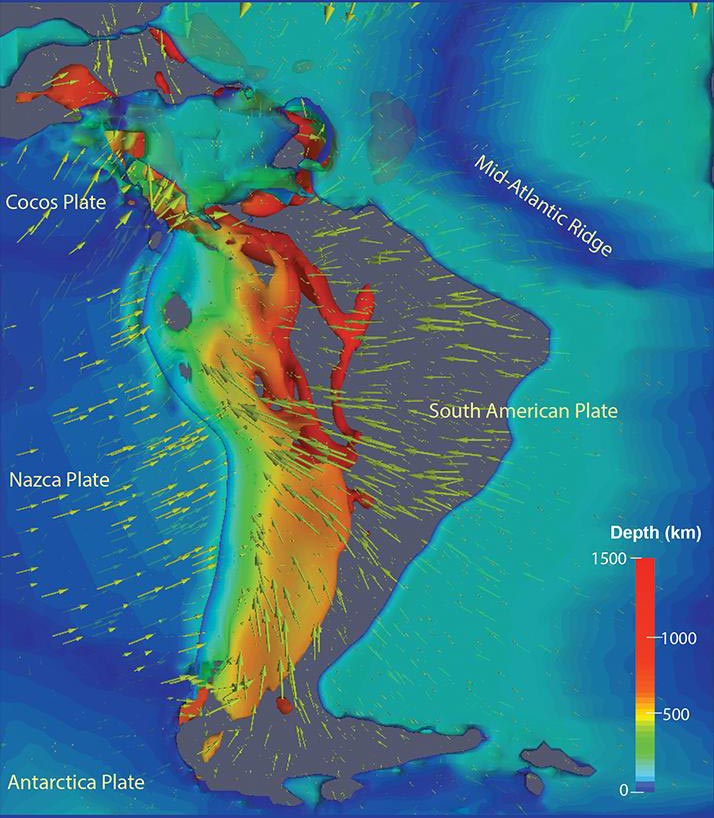

Researchers created a three-dimensional representation of predicted slab geometry and mantle flow. The image outlines areas with a temperature at 300 degrees Celsius cooler than the surrounding mantle, with different colors representing different depths. Oceanic plates and slabs are semi-transparent, and continents are entirely transparent. Green arrows represent velocity vectors inside the mantle
Credit: Lijun Liu, University of Illinois.
Contrary to posters you may have seen hanging on the walls in science buildings and classrooms, Lijun Liu, professor of geology at Illinois, knows that Earth's interior is not like an onion.
While most textbooks demonstrate the outer surface of the Earth as the crust, the next inner level as the mantle, and then the most inner layer as the core, Liu said the reality isn't as clear-cut.
“It's not just in layers, because the Earth's interior is not stationary,” Liu said.
In fact, underneath our feet there's tectonic activity that many scientists have been aware of, but Liu and his team have created a computer model to help better explain it — a model so effective that researchers believe it has the potential to predict where earthquakes and volcanoes will occur.
Using this model, Liu, along with doctoral student Jiashun Hu, and Manuele Faccenda from the University of Padua in Italy, recently published a research paper in the journal of Earth and Planetary Science Letters that focuses on the deep mantle and its relationship to plate tectonics.
“It's well-known that there are plate tectonics driving the Earth's evolution, but exactly how this process works is not entirely clear,” he said.
Liu and Hu looked specifically at the continent of South America to determine which tectonic factors contribute to the deformation, or the evolution, of the mantle.
To answer this question, the team created a data-centric model using the Blue Waters supercomputer at the National Center for Supercomputing Applications at Illinois. The sophisticated four-dimensional data-oriented geodynamic models are among the first of their kind.
“We are actually the first ones to use data assimilation models in studying mantle deformation, in an approach similar to weather forecasting,” Liu said. “We are trying to produce a system model that simultaneously satisfies all the observations we have. We can then obtain a better understanding about dynamic processes of the Earth evolution.”
While there are many debates in regards to how the Earth's internal evolution is driven, the model created by the team seemed to find an answer that better fits available observations and underlying physics. The team found that the subducting slab — a portion of the oceanic plate that slides beneath a continental plate — is the dominant driving force behind the deformation of the mantle.
Essentially, the active subduction of the slab determines most other processes that happen as part of a chain reaction. “The result is game-changing. The driving force of mantle flow is actually simpler than people thought,” Liu said. “It is the most direct consequence of plate tectonics. When the slab subducts, it naturally controls everything surrounding it. In a way this is elegant, because it's simple.”
By understanding this mechanism of Earth evolution, the team can make better predictions regarding the movement of the mantle and the lithosphere, or crust.
The team then evaluated the model's predictions using other data. Hu, the lead author on the paper, said that by comparing the predictions to tectonic activities such as the formation of mountains and volcanoes, a clear consistency emerged.
“We think our story is correct,” Hu said.
Consequently, the model also provides interesting insight on the evolution of continents as far back as the Jurassic, when dinosaurs roamed the Earth on Pangaea, the only continent at the time. This is still the team's ongoing research.
Liu said that in a separate paper that uses the same simulation, published by Liu and Hu in Earth and Planetary Science Letters in 2016, the model provided an accurate prediction for why earthquakes happen in particular locations below South America. He explained that earthquakes aren't evenly spread within the subducting slab, meaning there are potentially areas where an earthquake is more or less likely to take place.
“We found that whenever you see a lack of earthquakes in a region, it corresponds to a hole in the slab,” Liu said. “Because of the missing slab in the hole, there's no way to generate earthquakes, so we might be able to know where more earthquakes will take place.”
The model also explained why certain volcanoes might exist further inland and have different compositions, despite the common thought that volcanoes should exist solely along the coast, as a result of water coming off the down-going slab. As the model helps explain, a volcano can form inland if the slab subducts at a shallower angle, and a hole in the shallow slab allows for a special type of magma to form by melting of the crust.
“Ultimately this model will provide a promising way of solving the question of how and why continents move the way they do,” Liu said. “The answer should depend on what the mantle is doing. This is a way to much better understand Earth evolution.”
The team is currently expanding the model to analyze the entire globe.
“We are looking forward to more exciting results,” Liu said.











